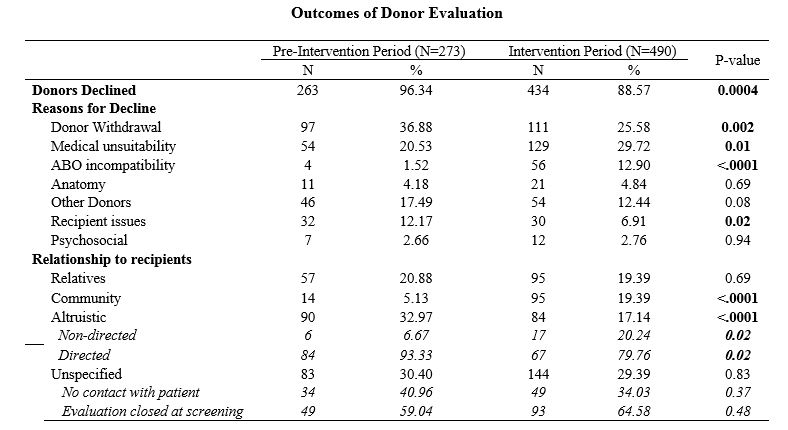Impact of a Liver Waitlist Candidate LDLT Educational Outreach Program on Referrals and Outcomes of Donor Evaluation
C. Saroli Palumbo, J. Batisti, R. Batra, J. Dopico, D. Haakinson, L. Hughes, M. Joyce, S. Klein, S. Kulkarni, D. Mulligan, P. Narayanan, M. Schilsky, R. Tomlin, K. Ventura, S. Emre, A. Liapakis
Yale, New Haven, CT
Meeting: 2019 American Transplant Congress
Abstract number: B349
Keywords: Donation, Living-related liver donors, Patient education
Session Information
Session Name: Poster Session B: Liver: Living Donors and Partial Grafts
Session Type: Poster Session
Date: Sunday, June 2, 2019
Session Time: 6:00pm-7:00pm
 Presentation Time: 6:00pm-7:00pm
Presentation Time: 6:00pm-7:00pm
Location: Hall C & D
*Purpose: Challenges to identify suitable candidates for living donor liver transplantation (LDLT) include low donor acceptance, recipient & provider team reluctance to pursue LDLT. A formal patient educational outreach program was initiated in Nov 2017 as part of a larger LDLT task force aimed to increase awareness of living donation. We aimed to determine the impact of this program on referrals to LDLT and observed donor approval rates.
*Methods: We reviewed LDLT evaluations following the launch of this program, designated intervention period (IP) 11.07.2017-11.06.2018, and compared them to a pre-intervention period (PIP) 11.07.2016-11.06.2017. The recipient education program consisted of an evening session of presentations from providers including hepatology, surgery, LDLT coordinator, social work, previous donors and LDLT recipients. Educational materials with resources to pursue LDLT and center-specific/national data were provided. Standardized, recurring multidisciplinary clinics were initiated for donor evaluation and donors were asked to attend with a care partner.
*Results: The number of referrals for LDLT evaluations nearly doubled in the IP compared to the PIP: 490 referrals for 36 potential recipients vs 273 referrals for 12 potential recipients, without a change in waitlist size. In the IP, 10 donors were approved (2.0%), 46 remain active in evaluation, and 3 LDLTs have occurred with 4 scheduled. In the PIP, similar approval rates were observed: 9 donors were approved (3.3%), all of whom progressed to LDLT. Donor denial rate, though substantial in both timeframes, was lower in the IP (88.6% vs 96.3%, P 0.0004). Main reasons for candidate decline included donor withdrawal, medical unsuitability and presence of other donors for a given recipient. The rate of donor withdrawal decreased in the IP (25.6% vs 36.9%, P 0.002). A rise in the proportion of donors arising from potential recipients’ community in the IP (19.4% vs 5.1%, P<.0001) was observed.
*Conclusions: A focused LDLT educational outreach program was associated with a rise in referrals for LDLT and a decrease in rates of candidate decline and donor withdrawal. Further benefits of programmatic approach, notably impact on actual LDLT rates, need to be evaluated.
To cite this abstract in AMA style:
Palumbo CSaroli, Batisti J, Batra R, Dopico J, Haakinson D, Hughes L, Joyce M, Klein S, Kulkarni S, Mulligan D, Narayanan P, Schilsky M, Tomlin R, Ventura K, Emre S, Liapakis A. Impact of a Liver Waitlist Candidate LDLT Educational Outreach Program on Referrals and Outcomes of Donor Evaluation [abstract]. Am J Transplant. 2019; 19 (suppl 3). https://atcmeetingabstracts.com/abstract/impact-of-a-liver-waitlist-candidate-ldlt-educational-outreach-program-on-referrals-and-outcomes-of-donor-evaluation/. Accessed December 22, 2025.« Back to 2019 American Transplant Congress

